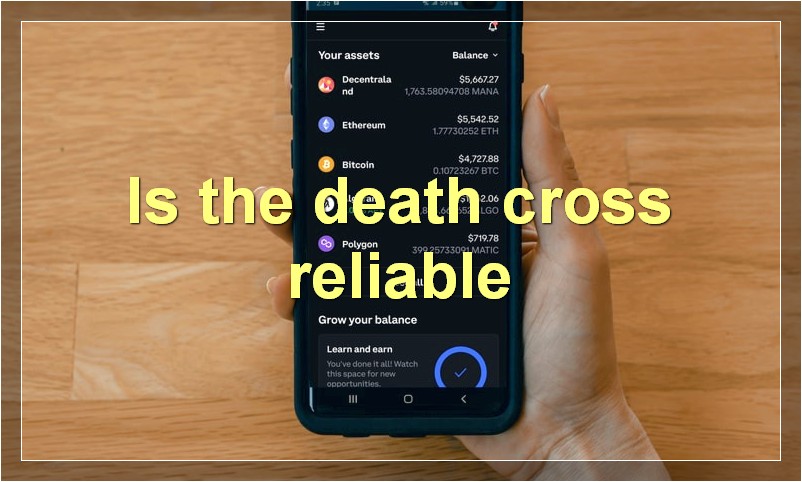If you’re looking to get into trading, it’s important to know the basics. One of those basics is understanding death crosses. In this article, we’ll explain what death crosses are and how to trade them.
What is a death cross
A death cross is a term used in technical analysis that refers to the crossover of a stock’s moving average (MA) with a longer-term MA. This signal is generally interpreted as a bearish indicator, as it suggests that the stock’s short-term trend has reversed and is now heading lower.
There are two ways to look at a death cross. The first is as a long-term trend reversal signal, in which case traders would begin to sell the stock or exit any long positions. The second way to interpret a death cross is as a short-term trading opportunity. In this case, traders would buy the stock after it has fallen sharply and is now oversold, with the expectation that the stock will rebound back towards its longer-term average.
Which interpretation you choose to follow will likely depend on your overall investment strategy and risk tolerance. If you are a long-term investor, then you may want to Sell or reduce your position in a stock when it experiences a death cross. On the other hand, if you are a more aggressive trader, you may view a death cross as an opportunity to buy the dip in an otherwise healthy stock.
No matter how you choose to interpret a death cross, it is always important to do your own research before making any investment decisions. And remember, even technical indicators should be just one part of your overall investment strategy.
What is the difference between a death cross and a golden cross

The death cross and the golden cross are two terms used to describe technical analysis patterns that can be found on a price chart.
The death cross occurs when the 50-day moving average crosses below the 200-day moving average. This is considered a bearish signal and often leads to further downside in the price.
The golden cross occurs when the 50-day moving average crosses above the 200-day moving average. This is considered a bullish signal and often leads to further upside in the price.
What are the implications of a death cross
A death cross is a term used in technical analysis that occurs when the 50-day moving average crosses below the 200-day moving average. This signals that the short-term trend is now bearish and could lead to further downside in the stock.
The implications of a death cross are two-fold. First, it signals that the stock is in a long-term downtrend. Second, it means that the recent rally may have been just a bear market rally and that further downside is likely. As such, investors should be cautious when considering buying a stock that has just experienced a death cross.
How do you trade a death cross
A death cross is a technical charting pattern that signaling the potential for a major sell-off in an asset.
The death cross appears when an asset’s short-term moving average crosses below its long-term moving average. This signals that the asset’s momentum has shifted from bullish to bearish, and that it may be time to sell.
To trade a death cross, you will need to closely monitor the asset in question and make a decision when you believe the time is right to sell. This pattern can be difficult to trade, so it is important to do your research and always use stop-loss orders to protect your capital.
What is the history of the death cross
The death cross is a technical analysis indicator used in the stock market and other financial markets to signal the potential for a major sell-off. The death cross occurs when the 50-day moving average crosses below the 200-day moving average. This is considered a bearish signal and often leads to further selling pressure in the market.
The death cross was first popularized by technical analyst Norman Fosback in the 1970s. It has since become a widely followed indicator by traders and investors across the globe.
The death cross can be a useful indicator for long-term investors to help time their entries and exits from the market. However, it is important to note that the death cross is not a perfect predictor of market movements and should be used in conjunction with other technical and fundamental analysis tools.
Is the death cross reliable

The death cross is a technical indicator that is used by some traders to signal when a stock is potentially about to enter into a long-term downtrend. It is created when the 50-day moving average crosses below the 200-day moving average. While the death cross can be a useful tool for some traders, it is important to remember that it is not always 100% accurate and should not be relied on blindly.
What are the benefits of trading a death cross
As a trader, one of the benefits of trading a death cross is that it can provide you with an early warning sign that a potential trend reversal may be occurring. By being aware of this potential reversal, you can then make adjustments to your trading strategy accordingly in order to try and profit from the market movement. Additionally, trading a death cross can also help you to Lock in gains or limit losses if you have an open position when the market reverses.
What are the risks of trading a death cross
A death cross is when the 50-day moving average crosses below the 200-day moving average and is considered a bearish sign. Some investors believe that it signals that a stock is about to enter a long-term downtrend. While there is no guarantee that this will happen, it is important to be aware of the potential risks before trading.
One of the biggest risks is that you could end up buying a stock that is about to enter a long-term downtrend. This could mean losses for you if you’re not careful. Another risk is that the market could turn around before the death cross happens, which would invalidate the signal. Finally, you need to be aware of false signals, which can occur during times of high volatility.
What other indicators should you use when trading a death cross
When the stock market is going through a period of uncertainty, you might want to keep an eye out for what’s known as a death cross. This occurs when the 50-day moving average crosses below the 200-day moving average, and it’s seen as a bearish signal that suggests further downside is ahead.
Of course, no single indicator should be used in isolation when making investment decisions. It’s always important to look at the bigger picture and consider other factors such as economic data, company fundamentals, and technical indicators. But if you’re wondering whether the death cross is worth paying attention to, the answer is yes – just don’t rely on it alone.
What time frame should you use when trading a death cross
When trading a death cross, you should use a time frame of 1-2 weeks. This will allow you to see the potential for a trend change and enter into a trade accordingly.

